
Butternut squash pie recipe
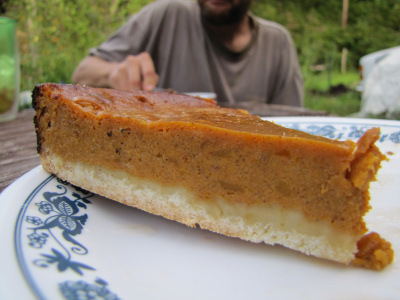 Do
you like pumpkin pies? If so, you're in for a treat because
butternut squash pies are twice as good. You can make
pumpkin-like pies out of any kind of winter squash, but after
taste-testing pie pumpkins, acorn squash, cushaw, and butternut we
concluded that the last was by far superior. That said, the
recipe below can be used to create a pie out of any kind of winter
squash. You can even turn Jack-o-lanterns into pie if they
haven't been sitting out for too long.
Do
you like pumpkin pies? If so, you're in for a treat because
butternut squash pies are twice as good. You can make
pumpkin-like pies out of any kind of winter squash, but after
taste-testing pie pumpkins, acorn squash, cushaw, and butternut we
concluded that the last was by far superior. That said, the
recipe below can be used to create a pie out of any kind of winter
squash. You can even turn Jack-o-lanterns into pie if they
haven't been sitting out for too long.
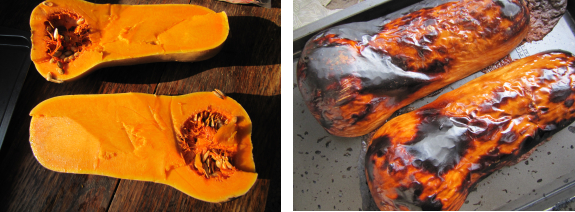
Step
1: Bake the butternut. Cut your butternut
squash in half (carefully!) and scoop out the seeds. Lay the two
halves, cut side down, on a cookie sheet and bake until the skin begins
to blacken and the flesh is very tender. You can bake the squash
at just about any temperature, so I try to plan this step to coincide
with my other baking needs, such as pizza night.
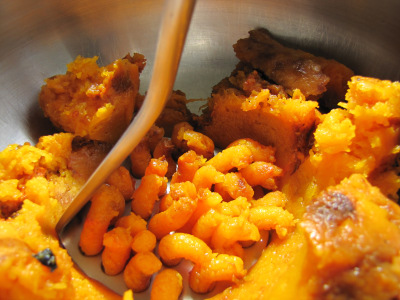
Step
2: Process the butternut. Cool the butternut and peel
off and discard the skin. Then mash up the flesh with a potato
masher (or just with the back of your spoon.) Measure out two
cups of flesh, which will equal one medium butternut, half of a large
butternut, or two small buttercups. I don't worry too much if my
butternut is a quarter of a cup too large or too small --- I throw it
all in.
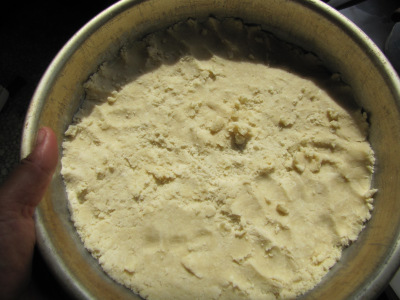 Step 3:
Make your crust.
I'm lazy, so I've settled on a quick and easy, pat-in-the-pan
recipe. I throw 1 cup of white flour, 0.5 tsp of salt, and 7
tablespoons of cold butter in the food processor and blend until the
butter is cut into coarse pieces. After adding two tablespoons of
cold water and blending a bit more, the dough generally starts to stick
together --- depending on your humidity, you might need to add more or
less water. Pour the dough into the bottom of your pan and press
it into place. Then put the pan in the fridge to stay cool while
you make the pie filling. (I like to make our pies in a cake pan
to leave room for more filling.)
Step 3:
Make your crust.
I'm lazy, so I've settled on a quick and easy, pat-in-the-pan
recipe. I throw 1 cup of white flour, 0.5 tsp of salt, and 7
tablespoons of cold butter in the food processor and blend until the
butter is cut into coarse pieces. After adding two tablespoons of
cold water and blending a bit more, the dough generally starts to stick
together --- depending on your humidity, you might need to add more or
less water. Pour the dough into the bottom of your pan and press
it into place. Then put the pan in the fridge to stay cool while
you make the pie filling. (I like to make our pies in a cake pan
to leave room for more filling.)
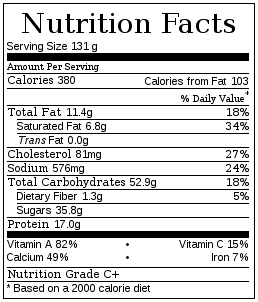 Step 4: Mix up the pie filling. Combine 2 cups of
baked butternut squash from step 2, 1.5 cups of evaporated milk or rich
cream, 0.25 cups of brown sugar, 0.5 cups of white sugar, 0.5 tsp of
salt, 1 tsp of cinnamon, 0.5 tsp of ginger, 0.25 tsp of allspice, and 2
eggs. Blend well. (I seldom have evaporated milk or cream
on hand, so I substitute a concoction of powdered milk and water ---
fill a cup with milk powder and slowly add water, stirring, until the
cup is full of liquid, then repeat with a half cup measurer. The
nutritional information reflects the extra protein from using
powdered milk rather than cream.)
Step 4: Mix up the pie filling. Combine 2 cups of
baked butternut squash from step 2, 1.5 cups of evaporated milk or rich
cream, 0.25 cups of brown sugar, 0.5 cups of white sugar, 0.5 tsp of
salt, 1 tsp of cinnamon, 0.5 tsp of ginger, 0.25 tsp of allspice, and 2
eggs. Blend well. (I seldom have evaporated milk or cream
on hand, so I substitute a concoction of powdered milk and water ---
fill a cup with milk powder and slowly add water, stirring, until the
cup is full of liquid, then repeat with a half cup measurer. The
nutritional information reflects the extra protein from using
powdered milk rather than cream.)
Step
5: Pour the filling into the crust and bake at 425 F for 15 minutes,
then at 350 F for about 30 minutes. This combination of
temperatures just happens to work quite well for baking a chicken as
well, so once again you can double up your oven time.
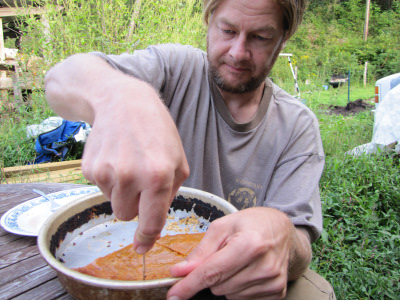 Step 6: Cool completely before eating. I usually ignore this
admonition, but with butternut pies, the spices really do meld and
taste better once the pie is thoroughly chilled.
Step 6: Cool completely before eating. I usually ignore this
admonition, but with butternut pies, the spices really do meld and
taste better once the pie is thoroughly chilled.
These pies are the
reason Mark became so
obsessed with making sure we have plenty of butternut squash on hand. Although no dessert
is precisely good for you, the hefty dose of protein and vitamins found
in an eighth of this butternut pie make me feel better about baking one
every week.
Want more in-depth information? Browse through our books.
Or explore more posts by date or by subject.
About us: Anna Hess and Mark Hamilton spent over a decade living self-sufficiently in the mountains of Virginia before moving north to start over from scratch in the foothills of Ohio. They've experimented with permaculture, no-till gardening, trailersteading, home-based microbusinesses and much more, writing about their adventures in both blogs and books.
Want to be notified when new comments are posted on this page? Click on the RSS button after you add a comment to subscribe to the comment feed, or simply check the box beside "email replies to me" while writing your comment.

This sounds and looks really yummy. I'm not sure I've ever seen butternut squash around here, though.
There's a variant on the spices you've used that's very popular here in so-called "speculaas" (translates as "brown spiced biscuit"). I think it might work quite well in this pie (quantities are just for proportion);
What kinds of winter squashes do they sell over there? (If any...)
Your speculaas sound a bit like ginger snaps (a kind of hard, spicey cookie, aka "biscuit.") Some folks do put cloves in pumpkin pies, but I think they're far too strong. I'll bet your spice list would make a spice-lover happy, though!
I've seen the odd pumpkin, but generally only in ethnic food stores. Not sure why. They are becoming more common, though.
Other none-native vegetables like bell peppers and tomatoes are quite popular here and are frequently grown here in glasshouses. And of course potatoes (which are more or less our staple food) aren't native to Europe either!
Since there can be multiple and very different looking cultivars in the same species, I find plant namings quite confusing. For instance, the cucurbita moschata is known here as the "muskaatpompoen" (nutmeg pumpkin) when it's round, but as the "flespompoen" (bottle pumpkin) when it's elongated in shape, and the latter looks to be what you call a butternut squash. Count me confused!
I never considered a pumpkin ethnic food. Although, to be fair, I don't think that most Americans actually know how to cook one --- we eat our traditional Thanksgiving pumpkin pie either straight from the store or made "from scratch" out of canned pumpkin. I can't imagine why winter squashes haven't become a more prominent food in peoples' diets, though --- they're delicious and so good for you!
The problem with scientific names for cucurbits (squashes, cucumbers, etc.), is that a lot of very different varieties are all in the same species. We've done so much breeding from the ancestral plant, that it's a bit like broccoli, cabbage, and collards --- if I told you their scientific name, I'm sure you'd rather have the common name so that you'd know what I was talking about. You did guess the scientific name right, though.
Well, often I don't have a clue as to the Dutch name for the plants or vegetables you mention. So I look up the scientific (latin) name on the English wikipedia, and use that to search for the Dutch name on the Dutch wikipedia. Works quite well.
Works quite well.
The same goes for wood, which interests me as an engineering material. There are sometimes many different names for one kind of wood. And the other way around, one name can be used for several totally different species, like e.g. ironwood (which I associate with lignum vitae).
(I know it's a bit silly to keep making comments on my own post, but it's how I keep track of recipe changes...)
Since we've got gobs of honey from our bees, I thought I'd see how the pie does as a sugar-free dessert. Deleting both types of sugar and adding a half a cup of honey to the filling made a pie that tasted even better than the original, especially if you take it out a bit prematurely.
I had less luck using honey in the chocolate crust --- stick to sugar there!
Anna, from this blog I see that you have a scientific bent. I thought you might be interested in this article from the NYT about the advantages of baking using a digital scale. I'm an American transplant to Canada, and I'm making your butternut squash pie recipe for Canadian Thanksgiving! I'll reserve the pumpkin pie for next month
http://www.nytimes.com/2011/09/14/dining/tipping-the-balance-for-kitchen-scales.html?_r=1&scp=1&sq=digital%20scale&st=cse